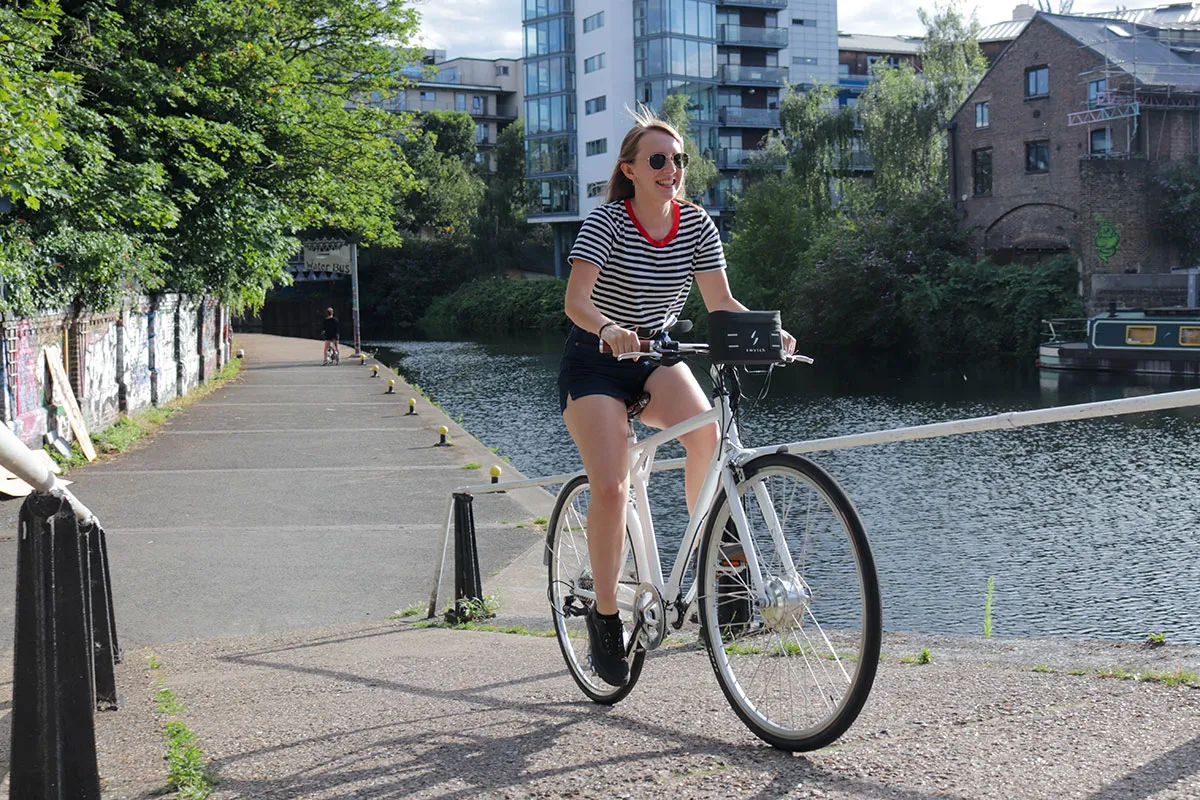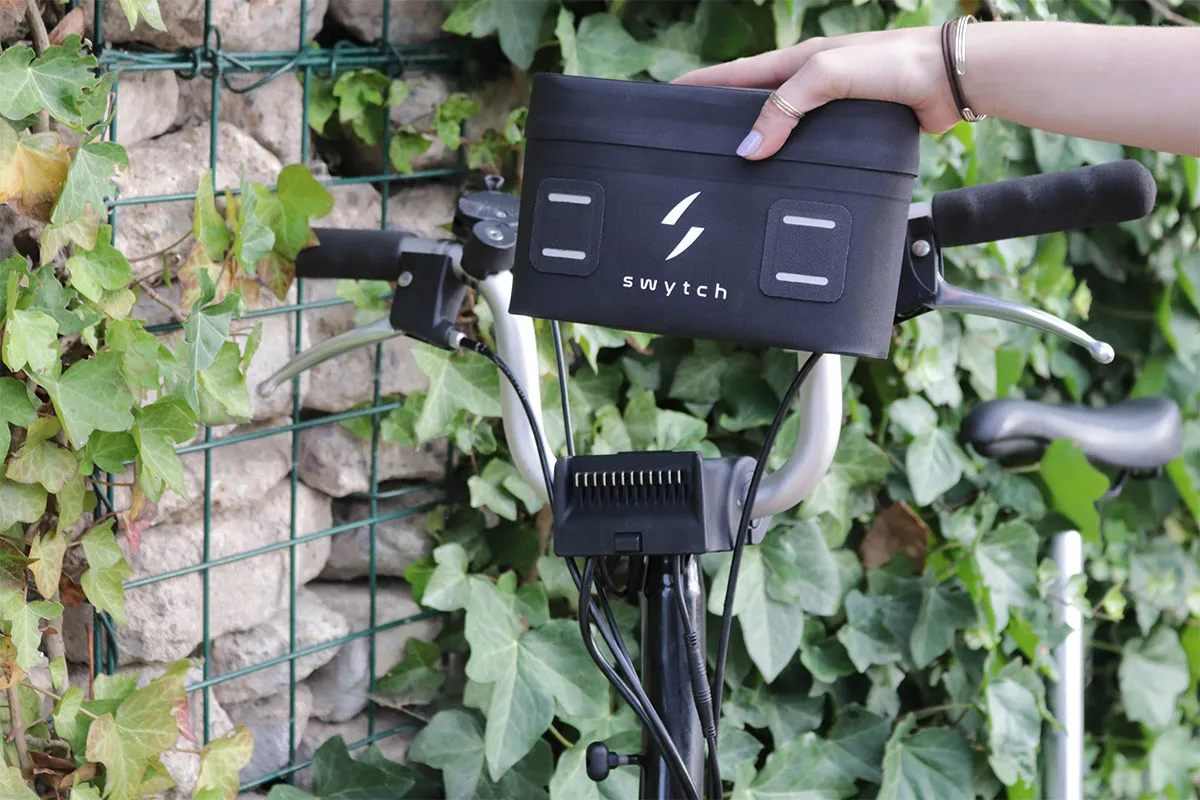SQUIRREL_13098619
I had such good intentions when I bought my bike. I was going to cycle into work every day, saving me money on the bus fare and getting exercise at the same time. But then I tried the journey, and often ended up arriving sweaty and out of breath – a victim of Bristol’s many hills.
In comes the Swytch eBike Conversion kit, and now I have a bit of extra electrical assistance to help me with the tricky parts. My bike is getting out and about more than ever before.
Swytch advertises itself as the world’s smallest and lightest ebike conversion kit, and says that it works on almost any bike. You can turn your bike electric whether it’s a mud-covered mountain bike, a retro step-through like mine, or even a penny farthing.
The kit is compatible with all gear types and all rim and disc brakes, but it won’t work with thru-axle bikes. If you’re not sure whether your bike is compatible, or what size of wheel to order, the Swytch customer service team can take you through it. While the Universal kit will work for most standard cycles, the Brompton kit is designed specifically for folding bikes.
Installing the conversion kit
The Swytch kit is fairly simple, made up of a few pieces. There’s a replacement front wheel which contains the motor, a power pack with a bracket to mount it to your handlebars, and a pedal sensor. You can pay extra for add-ons such as a brake sensor, which disconnects the motor as soon as you start to brake, and a throttle (though this isn’t road-legal in the UK).
The power pack comes in two tiers: Eco, which has a range of 35km, and Pro, which can go as far as 50km. Both have a power of 250W and are limited to 15mph in the UK. The kit adds a total weight of 3kg to the bike, between the power pack and the motor in the front wheel. For the Universal kit, the Eco model comes in at £999, and Pro costs £1,250.
Converting my bike was relatively straight-forward, and with the help of a friend with a bit more experience in bike maintenance, we managed it in a little over an hour. I was pleased to see that none of the changes are permanent – I could return it to a push bike if I decided the electric life wasn’t for me. That said, the kit adds so little weight that I’d be more likely just to cycle with the power pack switched off than go to the effort of changing over the front wheel again.
If you know what to look for, it’s clear that my bike has been altered. The big black box between the handlebars is immediately recognisable, and I spotted a couple of others with a Swytch out and about. And, of course, the motor in the front wheel isn’t particularly subtle. But since it doesn’t have the chunky frame I’ve come to associate with a typical ebike, it’s not completely obvious that my bike is electric.
What is it like to ride?

Two factors affect how much power the Swytch kit sends to the motor: how fast you pedal, and the power setting you select. On top of the power pack, sat between the handlebars, are two sets of lights. One indicates the charge left in the battery, and the other shows the power level, which is adjusted with a click of a button.
The first time I rode the bike, it was a little unsettling. I never felt unsafe, but it did feel like I couldn’t control my speed quite as closely as I wanted. I know how my bike responds when I ride, so to feel it power forwards more than I expected with every press of the pedal was odd. However, I got used to it quickly and speed control feels intuitive. Just like with a push bike, pedalling faster means you pick up speed – the difference is just how much.
As for the handling, there is a small difference – on my bike, at least. I could tell at first that the front is a little bit heavier, but it never got in the way of cycling, and I got used to it quickly. If you often take corners at high speeds, you should take care on your first few rides while you get used to it.
You can’t sit back, put your feet up and let the bike carry you up a difficult hill. The Swytch only provides power when you’re pedalling, and you still have to overcome gravity and air resistance as normal, so it’s perfectly possible to get out of breath. Even so, I managed to whizz up Bristol’s notorious Park Street without having to get off and push. I tried not to look too smug when I overtook a cyclist who had given up halfway.
Most of the time, the power pack will provide enough assistance to your pedalling on the lowest setting. That was enough to get me up to a comfortable speed on a flat road or a slight hill. I only tended to use the second or third power level out of five to get me up anything steeper. There’s not much point in using a higher power level on a flat road, since UK law prevents the motor from providing any power if you’re going over 15mph (24kmh).
How long does the battery last?

I can’t say for sure how much battery my commute uses, since the power level indicator is just five lights, but I’d expect it to go down one click by the time I get home, leaving maybe 80 per cent. If that means that I can cycle for around an hour and use only 20 per cent of the battery, then I can’t imagine any ride I’d do would risk running the battery flat.
However, as someone who likes to be chronically over-prepared, it seems strange to me that there isn’t a pocket on the power pack to carry the charging cable. You charge the bike by unclipping the power pack and taking it inside to a plug socket. If I was cycling into the office every day, I’d want to have the cable with me to give it a quick boost during the day if necessary.
What is it like to live with?
My cycle to work, which takes me around 45 minutes without electrical assistance, came down to just over half an hour with the Swytch kit. The time difference isn’t life-changing. But the big difference it makes is that I can arrive at work feeling refreshed from the cycle, not sweaty and out of breath. It also takes some of the pressure off my dodgy knees and makes longer cycles more doable.
Turning the power off completely while you ride is simple, so it’s not hard to save battery on an easy stretch. When it’s turned off, thanks to the lightweight kit and the “frictionless” motor, the bike didn’t feel noticeably heavier than without the kit installed.
The only time I noticed the extra weight was when carrying my bike upstairs – since the power pack and motor are both on the front, it made my bike a bit front-heavy. Though it’s a bit tricky to carry, it’s not a big issue for me, but something to take into account if you’re getting the kit due to injuries or disabilities that would otherwise make cycling inaccessible.
One of the biggest issues I can see is that the power pack takes up all the space on my handlebars, leaving no room for a headlight. The Pro kit comes with a light built into the front of the power pack, but the Eco doesn't. Both power packs have fabric straps on the front and top that you can use to add one, but you may have to buy a new headlight that can be attached this way.
Verdict

Cycling with the Swytch kit doesn’t take much time off an average cycle, but it makes it more comfortable and a bit more fun. So the question is: would I spend £1,000 or more on it, or would I choose a complete electric bike instead?
If I didn’t already have a bike I really like, I probably would choose a complete electric bike instead. That way, I can be confident that the bike is designed to have a motor attached, and would probably avoid the balance issues of adding an extra 3kg to the front. And for the same price as the Swytch kit, there are electric bikes out there that offer a similar range.
But Swytch regularly run half price offers on their website, if you’re willing to join a waitlist. At half price, even the Pro kit would pay for itself in bus tickets in around nine months – and that sounds like a much more sensible investment. Given this price, I’d prefer to keep the bike I already know and love and give it a power boost than shop around for a completely new ride.
SQUIRREL_13098619
Other products to consider…
Bafang Front Hub Motor
Guide price: From £380
Like the Swytch, this conversion kit from Bafang has the motor in the front wheel. You can choose between different types of display and different sizes of battery. This kit is only suitable for bikes with disc brakes, and the £380 price doesn’t include a battery.
SQUIRREL_TEXT_13098622
Rubbee X Base Model
Guide price: €579
The Rubbee X is a completely different kind of conversion kit. While the Swytch has a motorised front wheel, the Rubbee is a module that sits on your back tyre and drives it with a rubber flywheel attached to a motor. Because you don’t need to replace your wheel, installation is even simpler. You can change between Eco, Cruise and Power modes through the smartphone app. Though the range is limited to 16km, you can boost it by buying additional battery modules.
Bafang BBS01B
Guide price: From £360
The Bafang conversion kit places the motor low down on the bike, near the pedals on the bottom bracket. This makes it more stable than having the weight on the front wheel. The kit starts from only £360, but be aware that you’ll have to buy the battery separately, and installation will require a bit more know-how than other models.
SQUIRREL_TEXT_13098633
Carrera Crosscity Folding Electric Bike 2020
Guide price: £999
For the price of the Swytch Eco kit, you can get a complete folding electric bike from Carrera with the same claimed range as the Swytch Pro. And there’s no faff in installing a conversion kit. Even this little bike weighs 18kg though, so if you’re used to riding something a lot lighter, a conversion kit might be the choice for you.
Looking for more options? Why not check out our roundup of electric bikes, tried and tested? Or perhaps you're after somebicycle gadgets to pimp your ride? If you're just starting out and are looking for information, check out our beginner's guide to bike technology.